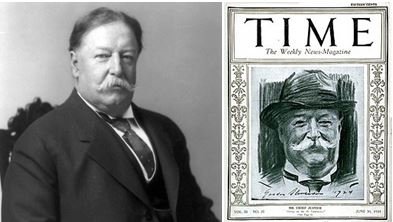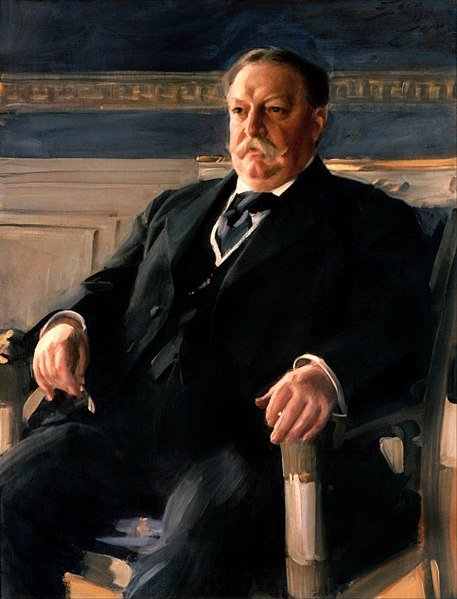William Howard Taft’s 12 Most Significant Accomplishments

William Howard Taft accomplishments
Fast Facts about William Howard Taft
Born: September 15, 1857 at Cincinnati, Ohio, U.S.
Death: March 8, 1930 at Washington, D.C., U.S.
Father: Alphonso Taft (a US Attorney General and later Secretary of War)
Mother: Louise Torrey
Siblings: 4, including Charles Phelps Taft (older half-brother)
Spouse: Helen Herron (Nellie) (married in 1886)
Children: 3 (Robert, Helen, and Charles)
Education: Yale University; University of Cincinnati Law School
Political Party: Republican
US Presidency: March 4, 1909 – March 4, 1913
Predecessor: Theodore Roosevelt
Successor: Woodrow Wilson
Most known for: Being the only person to have been US president and later Chief Justice of the United States
Accomplishments by William Howard Taft
Here is quick look at the top 8 accomplishments by William Howard Taft, the 27th President of the United States who served from March 4, 1909 to March 4, 1913.
He was only 23 when he became an assistant prosecutor
During his law school days, William Howard Taft was not the brightest of his; however, he did cover enormous grounds with sheer determination and hard work. , William naturally gravitated into the law profession considering the fact that his father, Alphonso Taft, was a judge and a Attorney General in President Ulysses S. Grant’s cabinet.
At Yale, he graduated second in a class of 121 pupils. After a Bachelor of Laws from the Cincinnati Law School, William garnered some experience working in his father’s law firm; this was after he had passed the bar examinations in Columbus, Ohio.
In 1880, at just the age of 23, William secured the position of assistant prosecutor for Hamilton County. He stayed in that job for about a year or so before moving on to his next big gig.
Read More:
An upright Internal Revenue Collector
In spite of the efforts of several White House chiefs to curb the spoils system, nepotism and favoritism were still rife throughout the latter decades of the 19th century. William Taft’s integrity was tested when he was asked by superiors above him to fire competent employees under him. Taft had been appointed Collector of Internal Revenue for Ohio’s First District during Chester A. Arthur’s presidency.
Rather than comply with the directives from above to dismiss competent employees who had fallen out with the ruling party, William Howard Taft resigned his position.
Sixth Solicitor General of the United States
Between 1890 and 1892, Taft served as the sixth Solicitor General of the United States. The office, which was first established during Ulysses S. Grant’s presidency, requires the holder to argue and present cases on behalf of the federal government before the U.S. Supreme Court. The Solicitor General is also allowed to file amicus curiae briefs before the court.
Taft was at a remarkable young age of 29 at the time of his appointment. The Ohio-born worked very hard to clear all outstanding cases that had been sitting in the office. In his two-year stay in the office, he won 15 out of 18 cases he presented before the nation’s highest court.
A US Court of Appeals Judge (1892-1900)
His illustrious work at the Solicitor General’s office caught the attention of President Benjamin Harrison. In early spring of 1892, Taft resigned from the office in order to take up an advance his judicial career as a federal judge. Taft was pretty much content with the work, quickly learning the ins and outs of the job.
He was not as conservative as many people think he was. As a federal judge, He objectively supported unions’ right to freely organize and agitate for better working conditions. Especially on negligence on the part of employers, Taft always ruled in favor of employees. A case in point was in Voight v. Baltimore & Ohio Southwestern Railway Co (1900), where a worker got injured.
William Howard Taft uplifted the socio-economic livelihoods of Filipinos
When President William McKinley tapped Taft to be a member of the civilian commission that would run the newly annexed country of the Philippines, Taft was very reluctant. In all honesty, Taft was not an astute politician. What he best excelled at was in law. Nevertheless, Taft accepted McKinley’s offer and sailed to the Philippines in April 1900 to serve as the first governor-general of the island.
Opposed to colonial rule, Taft during his tenure as governor-general of the Philippines worked very hard to get Filipinos ready for self-government. He was against any maltreatment of Filipinos as racially inferior to Americans. He established programs in education, health, agriculture and arts that uplifted the socio-economic livelihoods of Filipinos. Owing to his devotion to the Philippines, a number places in the country were named after him.
Secretary of War under President Theodore Roosevelt
Unbeknownst to many people, Taft was actually one of the people who urged President McKinley to appoint Theodore Roosevelt to the position of Assistant Secretary of the Navy. The young and upcoming Teddy Roosevelt went on to take the world by storm, becoming a war hero in the Spanish-American War and later Vice President in McKinley’s second term. And upon Teddy becoming the president of the United States after McKinley assassination in 1901, Taft was appointed Secretary of War (42nd in the nation’s history) in January 1904. Initially, Taft was reluctant to take President Roosevelt’s offer. This was due to his commitment to the people of the Philippines.
As secretary of war, Taft supervised the construction of Panama Canal, which was completed in August 1914. Following Cuba’s request for America’s help in resolving the conflict that was brewing, Taft briefly served as the Provisional Governor of Cuba.
Elected 27th President of the United States

William Howard Taft
In the lead up to the 1908 U.S. presidential election, Taft was tapped by President Theodore Roosevelt to succeed him in the White House. The two men had a lot in common, and for years, Taft had served Teddy in several troubleshooting capacity.
With the support of Roosevelt, Taft easily won the Democratic Party nomination for the election. In November, 1908, he faced off with William Jennings Bryan. Taft’s campaign was always at odds with the free silver policy of veteran politician Bryan. Taft viewed free silver as a form economic radicalism. The American people backed Taft and voted him into the White House. Taft won 321 electoral votes, compared to Bryan’s 162. He also pulled close to 52% of the popular votes as against Bryan’s 43.04%.
On March 4, 1909, Taft was sworn into the White House as the our nation’s 27th President.
Taft restructured the State Department
Taft appointed Philander Knox to the Secretary of State Department. Knox was a veteran Attorney General. Taft combined brilliantly with Knox to restructure the State Department. He once stated that the State Department should move from meeting the needs of 1800 to meeting the needs of the 1900s. To accomplish this Taft and Knox rolled out several training programs in the department. The department was also restructured into geographical divisions – Latin American, Western Europe, and the Far East.
He promoted American businesses abroad
Taft also tried to reduce America’s interference in Europe’s affairs. Instead he turned his attention to Latin American and East Asian countries, where he provided financial aid in exchange for diplomatic influence (i.e. the Dollar Diplomacy). All of his efforts were aimed at fulfilling the Monroe Doctrine on the American continent.
Taft also made sure that the diplomats and State Department’s officials had adequate training in order to advance America’s interest through diplomacy and the various consuls in Latin America.
An antitrust crusader against unethical businesses and monopolies
The Taft administration, which was one term by the way, filed over 70 antitrust lawsuits against big businesses in the manufacturing, oil and railway industry. To put into perspective just how staggering that number was; Theodore Roosevelt’s close-to-eight year’s administration filed just under 40 cases.
Taft was truly a big opponent trust and big business combinations, using anti-trust legislation to halt businesses from engaging in price fixing and unethical practices that decimated competition in the market. Some of the companies that President Taft and his administration battled in the courts were: John D. Rockefeller’s Standard Oil Company; the American Tobacco Company; and United States Steel.
Taft did win many of those antitrust lawsuits. For example, he was successful in getting Standard Oil divided into seven smaller chunks.
President William Taft made six appointments to the Supreme Court
William Howard Taft’s presidency was not as flamboyant and charismatic as his predecessor’s (President Theodore Roosevelt). Taft was simply good at maintaining and enforcing reforms – things that are not considered fancy to the American public. As a result of this, some of his significant accomplishments have gone under the radar in America’s history.
Did you know that William Taft made six appointments to the U.S. Supreme Court? The only people that have surpassed that number were George Washington and Franklin D. Roosevelt. Again, it must be emphasized that President stayed only four years in the White House.
President Taft appointed Horace H. Lurton of Georgia in 1909; New York Governor Charles Evans Hughes in 1910; promoted Justice Edward Douglass White to the Chief Justice seat in 1910; Willis Van Devanter of Wyoming in 1910; Democrat Joseph R. Lamar of Louisiana; and Mahlon Pitney.
Taft also made 13 appointments to the federal courts of appeal; 38 to the US district courts; and a number of appointments to the United States Commerce Court and the United States Court of Customs Appeals.
10th Chief Justice of the United States
It is unclear when Taft first harbored intentions to become Chief Justice of the nation’s highest court, but it was probably during his time as a student in Cincinnati Law School. Interestingly, Taft turned down nominations on two occasions (in 1902 and 1905) to serve on the bench of the U.S. Supreme Court.
After leaving the White House in 1913, Taft went straight back into law, teaching for more than a decade at Yale. So when the nomination for the chief justice of the Supreme Court came knocking at his door in 1921, Taft was more than eager to accept it.
The former president of the United States wanted nothing more than to serve on the bench. After he was nominated by President G. Harding, Taft was confirmed by the Senate, 61 to 4. He was sworn into office on July 11, 1921. He went on to leave a long-lasting mark on the court by streamlining the court’s procedures. He was also involved in modernizing the court’s infrastructure.
William Taft Howard holds the record of being the only U.S. President to have served on the bench of the U.S. Supreme Court.

William Howard Taft quote
Other Notable Achievements of President William Howard Taft
- In 1887, Cincinnati Governor Joseph B. Foraker appointed him to the Superior Court of Cincinnati. For his subsequent five years in the court, Taft had to contest and win his first election.
- The Cincinnati Law school appointed Taft dean and professor in 1896.
- Heavily involved in promoting arbitration and alternative conflict resolution techniques among nations. For this, he has been revered by many for his knowledge in international law.
- William Howard Taft was professor of law at Yale between 1913 and 1921.
- He was a founding member and the first president of the League to Enforce Peace in 1915. The organization aligned with Taft’s preference of arbitration as the best conflict resolution approach. The league campaigned to stop international conflict among nations during World War I.
- He was appointed chair of the American Red Cross’ executive committee in 1917.
- Taft encourage the usage of arbitration treaties with European powers, Preferring peaceful means to resolving conflicts with European nations.
- In 1913, he was elected president of the American Bar Association.




























great summary helleped alot with my grade